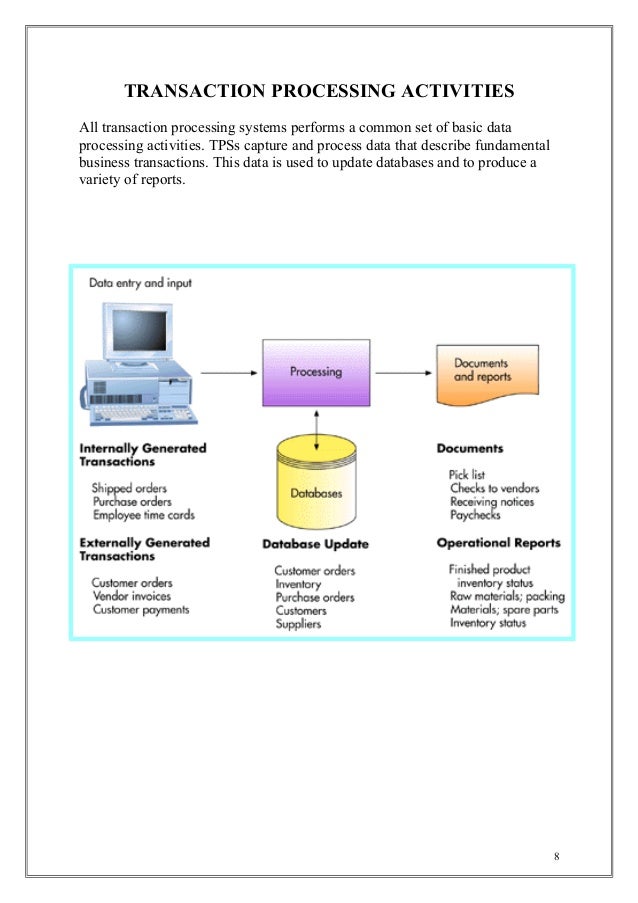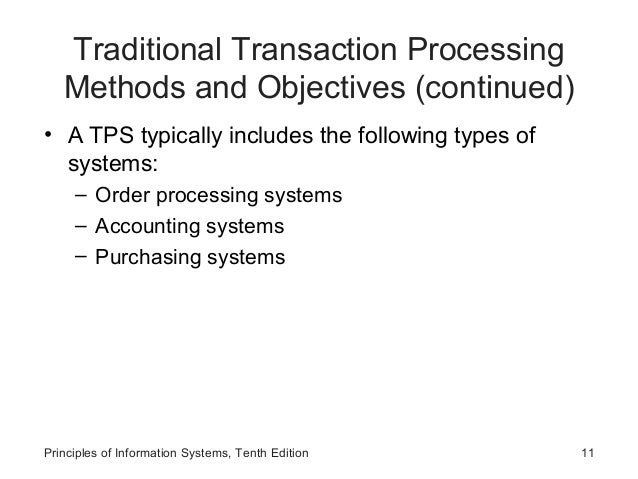

A transaction processing system has 3 main purposes: keep records about the state. This type of system processes data about transactions, which are events that have occurred that affect the business, such as the sale or purchase of goods. While the reports produced by MIS are scheduled reports (monthly financial statements) and exception reports (for example credit reports). The main information systems used for operational support in a business are transaction processing systems. All these documents do not help in decision making. TPS generates action documents (for example purchase orders and pay cheques), information documents (for example sales orders and sales receipts), control listings that include transaction logs and turnaround documents. The documents generated by transaction processing systems and management information systems also differs. It must also be noted that MIS uses compressed and summarized data provided by the TPS, while TPS deals with raw data.


The outputs of MIS are the summary reports that are used by the middle managers. Because managers look to the data generated by the TPS for up-to-the-minute information about what is happening in their companies, it is essential to the day-to-day operations of business that these systems function smoothly and without interruption. The activities performed by MIS are taking high volume transaction level data as an input and then processing this input based on simple models. Transaction processing systems are boundary-spanning systems that permit the organization to interact with external environments. The input activity involves data entry, transaction processing, TPS file and database processing and TPS documents and report generation. The activities performed by TPS are different from that of MIS. There are two types of Transaction Processing System (TPS). Transaction Processing System (TPS) is an information processing system for all business transactions involving collection, modification and retrieval of transaction data. The users of TPS come on the lower most level in the management hierarchy while the users of MIS are the mid level managers. A Transaction Processing System (TPS) perform routine operations and serve as a foundation for other systems. A standard system cost measure is stated and used to define. TPS on the other hand, performs routine operations for supervisory executives which include storing, retrieving, possessing, creating and formatting data. These benchmarks measure the performance of diverse transaction processing systems. The system helps compare this data to facilitate decision-making and answer questions. MIS provides information about internal operations to managers for decision making, planning and analysis. This article will tell the difference between the two based on the type of users, activities, report generation and type of data.

These are now-adays widely used in almost every spheres of business, such as online purchasing of tickets, online booking, etc.TPS stands for Transaction Processing Systems and MIS stands for Management Information Systems. For example, a company may want to process the payroll of its employees in a weekly or bi-weekly manner, thus the batches of employee salaries will be processed. Computerized system that performs and records the daily routine transactions necessary to conduct the business. Thereafter, these orders are processed to initiate invoicing, account receivables and inventory control processing. Transaction Processing System A Transaction Processing System (TPS) is a type of information system that collects, stores, modifies and retrieves the data transactions of an enterprise. Order Processing: With the help of TPS applications, orders are collected from clients either manually or through mails and telephonic calls. These are commonly used for preparing payroll or salary of the employees.Ĭ. Payroll Applications: These are the applications that help to execute payroll programs using terminal and online processing. Automatic Teller Machine (ATMs): These are those machines that handle the bank transactions through the use of specialised computer programs.ī. Some of the examples of Transaction Processing System- a.Fe enlisted as:Ī. Transaction Processing System (TPS) refers to a computerised system that records, processes, validates and stores routine transactions that occur in various functional areas of a business on daily basis.


 0 kommentar(er)
0 kommentar(er)
